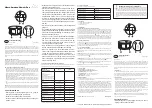
3-2
Return to
KPXI-CON-900-01 Rev. A / January 2007
Section 3: Getting Started
KPXI System Controller User’s Manual
Introduction
This section gives a summary of what is required to set up an operating system using the Model
KPXI-CON controller. Hardware installation and BIOS setup are also discussed. Note that the
Model KPXI-CON controller is shipped with CPU, RAM, HDD, and Windows XP
®
operating
system preinstalled.
Installing the Model KPXI-CON controller
Use the following procedure to install the Model KPXI-CON controller into a PXI chassis. Consult
your PXI chassis user guide for specific instructions and warnings.
Step 1:
Plug in your chassis before installing the Model KPXI-CON controller. Make sure the
system power is turned off.
Step 2:
Remove the blank face panel from the system slot.
Step 3:
Align the top and bottom edges of the board with the card guides on the chassis, then slide
the board into the chassis until resistance is felt.
Step 4:
Move the locking handle in an inward direction until it is fully latched. Please note that
slight resistance will be felt while inserting the board. If this resistance is more than under
normal conditions, check to ensure that there are no bent pins on the backplane and that
the board’s connector pins are aligned properly with the connectors on the backplane.
Step 5:
Verify that the board is seated properly. Secure the four screws at the top and bottom of
the front panel; connect the appropriate cables to the board. The system can now be
powered on.
shows a Model KPXI-CON controller being installed in the system slot of a typical
Keithley Instruments chassis.
How to remove the controller from the PXI chassis
Step 1:
Power off the chassis.
Step 2:
Loosen the four screws in the front panel.
Step 3:
Press down on the red locking tab on the ejector handle then press down on the ejector
handle itself which will eject the controller from its seated position.
Step 4:
Slide the controller out of the chassis.
CompactFlash card installation
The CompactFlash Card (or CF storage card) is widely used in digital consumer devices like
PDAs, digital cameras, and MP3 players. The CF format features anti-shock and anti-vibration
properties, improved environmental tolerance, low power consumption, a small form factor, and
higher reliability. Plus, it has been widely accepted in the industrial and embedded application
field.
The Model KPXI-CON controller has an external CompactFlash socket. The external CF interface
is hot swappable so users can install or remove via the front panel while the system is running.
BIOS configuration overview
The Basic Input/Output System (BIOS) is a program that provides the basic level of
communication between the processor and peripherals. In addition, the BIOS also contain code for
various advanced features found in the system board. The BIOS setup program includes menus
Содержание KPXI
Страница 96: ......
















































